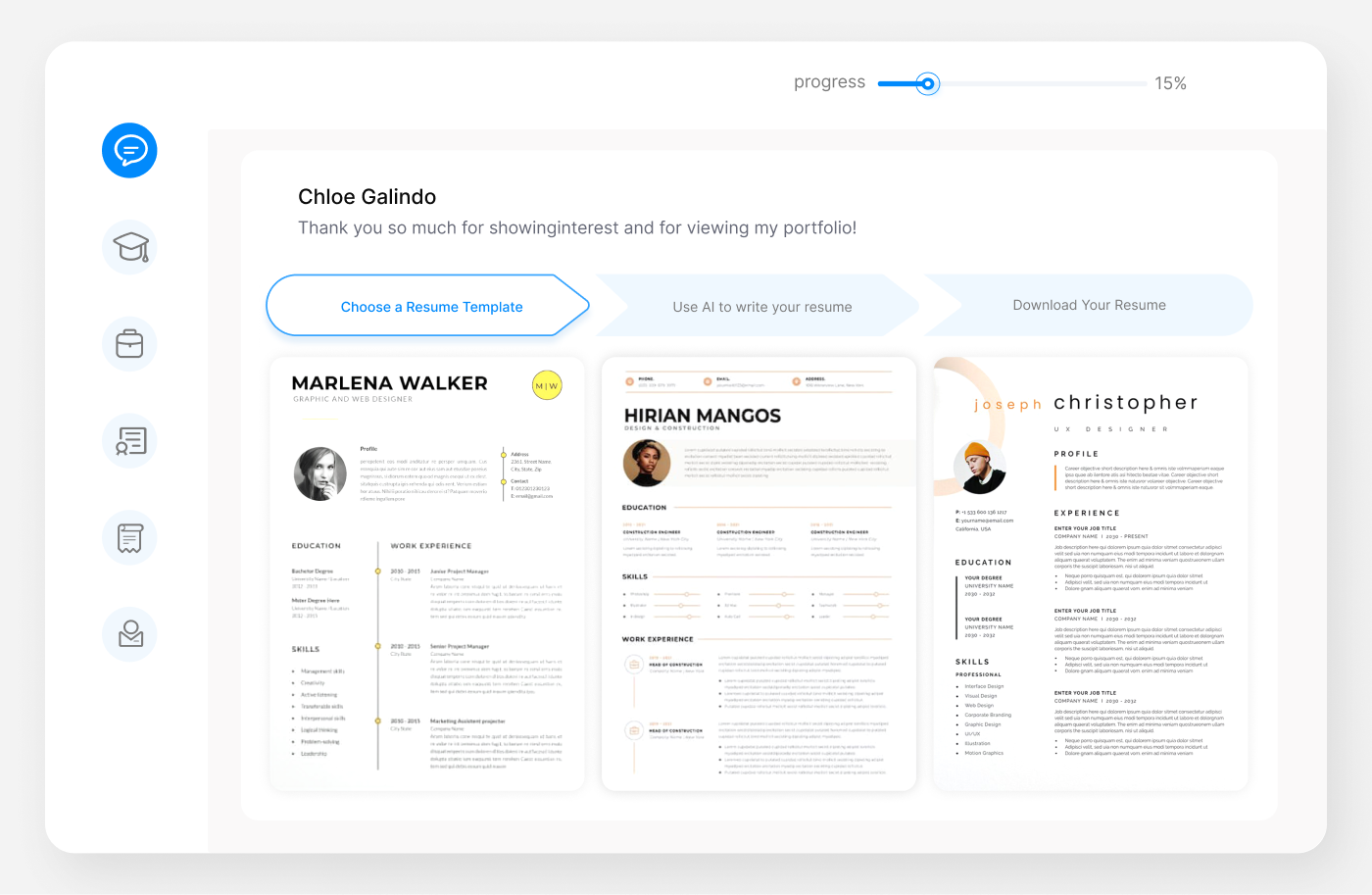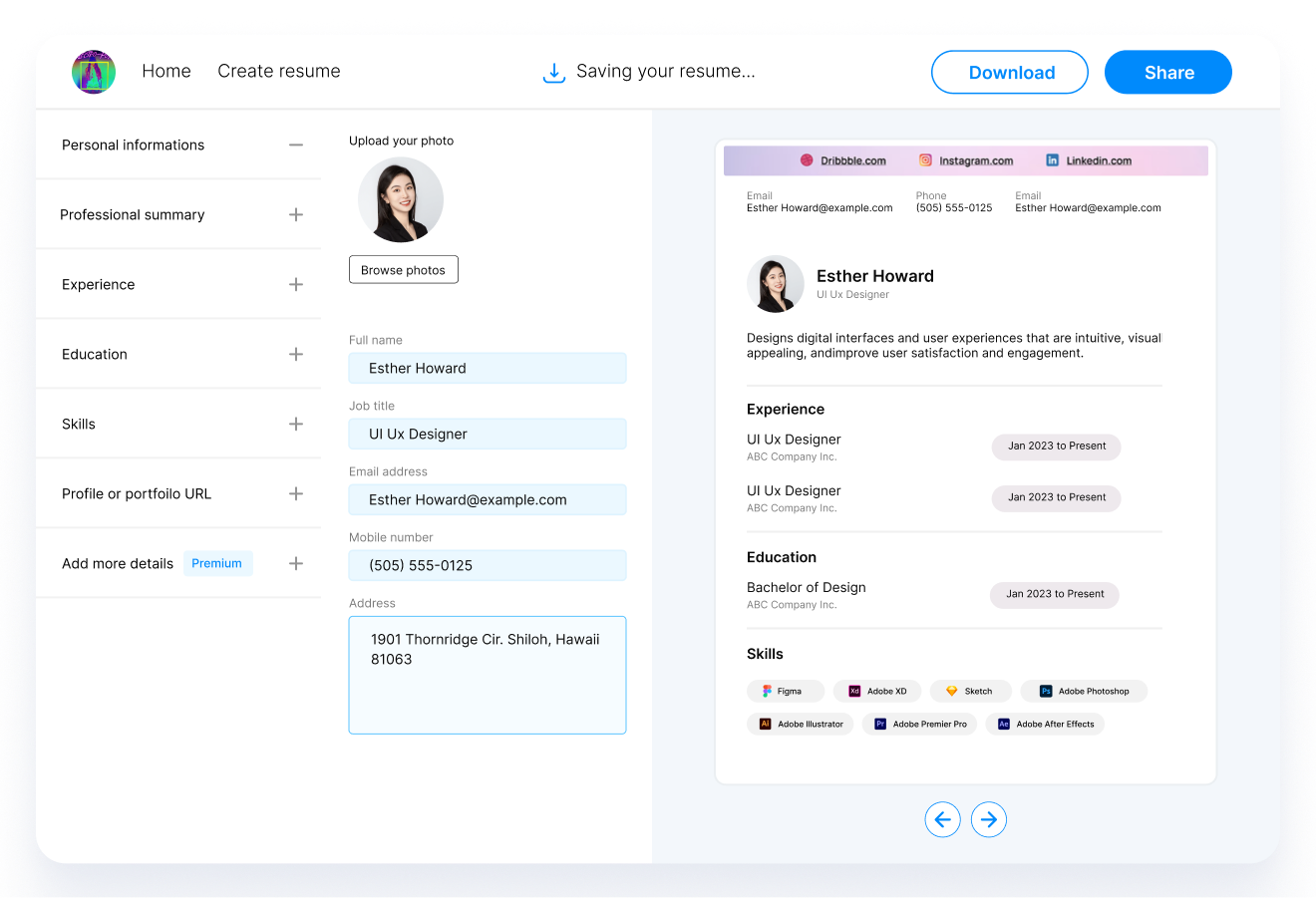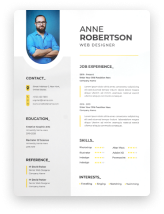In the realm of craftsmanship and construction, your resume is your most powerful tool—not the saw, not the hammer, but the document that showcases your skills, experiences, and the precision of your craft. Whether you're a seasoned carpenter with years of experience or a novice looking to nail your first job in the field, understanding how to present your expertise on paper is crucial. This guide is tailored specifically for carpenters seeking to build a resume that stands out, secures interviews, and ultimately lands the job. From the foundational structure of your resume to the intricate details that make your application unique, we'll cover everything you need to know to construct a compelling narrative of your career.

Sample Carpenter Resume
Elijah Carter
Carpenter
Phone: (555) 123-4567
Email: elijahcarter@carpentrymail.com
LinkedIn: linkedin.com/in/elijah-carter-carpentry
PROFILE
Dedicated and skilled Carpenter with over 8 years of experience in residential and commercial construction projects. Expert in designing, building, and installing custom cabinetry and furniture. Strong ability to read and interpret blueprints and drawings, ensuring all projects are completed with precision and within budget. Proven leadership skills, overseeing teams to deliver high-quality workmanship on time.
EXPERIENCE
Lead Carpenter
Sunrise Construction
Denver, CO
March 2018 - Present
- Supervise a team of 10 carpenters, coordinating tasks and ensuring projects are completed on time and to the highest standards.
- Spearheaded the construction of a 50-unit residential complex, resulting in a 20% increase in company revenue.
- Implemented new inventory management system, reducing material waste by 15%.
Carpenter
Green Homes
Boulder, CO
June 2013 - February 2018
- Specialized in eco-friendly building practices, contributing to the construction of over 30 sustainable homes.
- Led the custom kitchen cabinetry design and installation for the Boulder Eco-Living Expo showcase home, earning the "Best in Show" award.
- Conducted detailed site evaluations, measurements, and estimates for new projects.
EDUCATION
Associate Degree in Carpentry
Colorado Community College
Denver, CO
Graduated May 2013
SKILLS
- Proficient in using hand and power tools
- Expertise in blueprint reading and architectural drawings
- Strong mathematical skills for precise measurements
- Excellent communication and team leadership abilities
- Knowledgeable in building codes and safety regulations
CERTIFICATIONS
Certified Journeyman Carpenter, United Brotherhood of Carpenters, 2015
VOLUNTEER EXPERIENCE
Habitat for Humanity, Carpenter Volunteer
2016 - Present
- Volunteer monthly, contributing carpentry skills to build homes for underprivileged families.
Crafting the Perfect Structure for Your Carpenter Resume
A well-structured resume is your blueprint for success in the competitive field of carpentry. It's the framework that showcases your professional journey, skills, and accomplishments. Here's how to nail the format and organize your resume for maximum impact:
Choose the Right Resume Format
Begin with selecting the most flattering format for your carpentry resume. The chronological format is ideal for those with a solid work history, allowing you to list your experiences from the most recent to the oldest. However, if you're changing careers or have gaps in employment, a functional or combination resume might better serve your needs, emphasizing skills over timeline.
When choosing a resume format, consider your career trajectory and the job you're applying for. A chronological format works well for those with a consistent work history in carpentry, while a functional format might be better if you're transitioning from another field or have gaps in your employment.
Optimize the Header Section
Your header should not just list your name and contact information; it should invite potential employers to get in touch. Ensure your email address is professional, and consider adding a LinkedIn profile or online portfolio to showcase your work.
John Doe
Carpenter
123 Main St., Anytown, USA
(555) 123-4567
johndoe@email.com
linkedin.com/in/johndoe
Engaging Professional Summary or Objective
Tailor this section to the job you're applying for, highlighting your years of experience, key skills, and what you aim to bring to the position. A compelling summary can set the tone for the rest of your resume.
Skilled carpenter with 10+ years of experience in residential and commercial construction. Expertise in custom woodworking, blueprint reading, and project management. Seeking to leverage my skills and knowledge to contribute to XYZ Company's high-end residential projects.
I am a carpenter looking for a job. I have some experience and am a hard worker.
Detailed Work Experience
In this section, go beyond listing your job duties. Highlight specific projects you've worked on, challenges you've overcome, and the value you added to your team or project. Use action words to bring your experiences to life.
Lead Carpenter
ABC Construction
2015 - Present
- Managed a team of 5 carpenters in the construction of a 100-unit luxury apartment complex.
- Implemented lean construction techniques, resulting in a 15% reduction in project timeline.
- Collaborated with architects and engineers to develop innovative solutions to structural challenges.
Education and Certifications
While carpentry is often a trade learned on the job, any formal education, apprenticeships, or certifications you have can set you apart. Be sure to list them here, especially if they're a requirement for the job you're applying for.
If you have relevant coursework or training, even if it didn't lead to a degree, consider including it in this section. It shows your commitment to learning and developing your craft.
Skill Section That Highlights Your Craftsmanship
Carpentry is a skill-rich profession. Include technical skills like blueprint reading, woodworking, and proficiency with power tools, as well as soft skills like problem-solving, communication, and teamwork.
A Touch of Personality
Lastly, don't forget to add a personal touch to your resume. Whether it's a brief mention of your passion for sustainable building practices or a hobby that has honed your precision and attention to detail, a glimpse into your personality can make your resume memorable.
Remember, the key to a great resume is not just listing your experiences but telling a compelling story of your professional journey. Think of your resume as a project you're crafting from the ground up, with each section a vital component of the whole. By following these guidelines, you'll be well on your way to creating a resume that stands out in the stack and gets you one step closer to landing your next carpentry job.
Resume Summary or Objective: Carving Your Niche with Precision
In the carpentry trade, where every cut and measure matters, the summary or objective section of your resume is your chance to make the first precise cut. This is where you define your professional identity, showcase your expertise, and, most importantly, capture the hiring manager's attention.
Summary for the Seasoned Carpenter
If you have years of experience under your tool belt, use the summary to highlight your most impressive projects, leadership roles, and what you bring to the table.
Seasoned carpenter with over a decade of experience specializing in custom furniture design and architectural woodwork. Proven track record of managing large-scale residential and commercial projects from conception to completion, ensuring craftsmanship that exceeds expectations.
Objective for the Aspiring Apprentice
If you're new to the field or seeking to pivot your career into carpentry, the objective allows you to articulate your career goals and enthusiasm for learning the trade.
Aspiring carpenter with a passion for sustainable building practices and a strong foundation in woodworking. Eager to develop my skills through an apprenticeship, contributing to innovative construction projects while advancing my knowledge of modern carpentry techniques.
Both the summary and objective should be tailor-made for the job you're applying for, reflecting the specific skills and qualities the employer is seeking. It's your elevator pitch—make every word count to construct a compelling case for why you're the ideal candidate for the job.
Highlighting Your Craft: Detailing Work Experience on Your Carpenter Resume
The work experience section is the core of your carpenter resume, where you showcase the depth of your craftsmanship and the breadth of your expertise. Here's how to frame your experience to demonstrate your capabilities and achievements:
Quantify Your Impact
Use numbers to give a clear picture of your contributions.
Led a team of 5 carpenters in the construction of a 200-unit residential complex, completed 3 weeks ahead of schedule, under budget by 10%.
Detail Your Projects
Don't just list tasks; narrate your role in significant projects. Describe the type of construction or carpentry work, the tools and techniques you mastered, and the project outcome.
Specialized in custom kitchen cabinetry, designing and installing over 50 custom kitchens with a focus on maximizing space and aesthetic appeal.
Emphasize Problem-Solving Skills
Show how you've tackled challenges or improved processes. Highlighting problem-solving abilities can set you apart.
Developed a cost-saving inventory management system that reduced waste by 20% and improved project completion time.
Mention Leadership and Collaboration
If you've had the chance to lead projects or teams, detail these experiences to showcase leadership potential. Likewise, emphasize teamwork and collaboration to show you're a team player.
Educational Pathways: Building Your Foundation in Carpentry
Your education, apprenticeships, and certifications provide the foundation of your carpentry career. While hands-on experience is paramount, formal education and training can be a significant advantage:
Apprenticeships and Vocational Training
Highlight any apprenticeship programs or vocational training you've completed. These programs are crucial in carpentry, offering both practical skills and theoretical knowledge.
Certifications
Certifications can differentiate you in a pool of candidates. Whether it's a general carpentry certification, safety certifications, or specialized training in areas like green building practices, list them prominently on your resume.
Continuing Education
If you've taken additional courses to hone specific skills (like advanced woodworking, CAD software for design, or sustainable construction techniques), include these to show your commitment to ongoing learning and excellence in your craft.
For both sections, the key is specificity and relevance. Tailor your resume to reflect the skills and experiences most applicable to the job you're targeting. Your work experience and education are the proof points of your capabilities, painting a picture of a skilled, knowledgeable, and adaptable carpenter ready to take on any project.
Showcasing Your Skills: The Art of Carpentry on Your Resume
The skills section of your carpentry resume is where you get to showcase the specific abilities that make you stand out as a carpenter. This section should be a blend of hard skills, which are job-specific abilities, and soft skills, which are personal attributes that help you succeed in a work environment. Here's how to construct this crucial part of your resume:
Hard Skills for Carpenters:
- Technical Proficiency: List the tools and equipment you're proficient with, such as power saws, drills, planers, and sanders.
- Blueprint Reading and Design: Highlight your ability to read and interpret blueprints and architectural drawings.
- Material Knowledge: Show your expertise in selecting and utilizing the right materials for various projects, including wood types, hardware, and finishes.
- Safety Protocols: Emphasize your knowledge of safety standards and practices in carpentry work.
Soft Skills for Carpenters:
- Attention to Detail: Carpentry is an art that requires precision. Highlight your meticulous nature.
- Problem-Solving: Showcase examples of how you've tackled challenges on the job.
- Communication: Your ability to communicate with clients, architects, and team members is vital.
- Time Management: Demonstrating your ability to manage projects efficiently can be a significant asset.
Enhancing Your Resume with Additional Sections
Your resume should also include sections that paint a fuller picture of you as a professional. These additional sections can give you an edge by showing off your comprehensive skill set and experiences:
- Certifications: Beyond basic carpentry certifications, include any specialized credentials you've earned, such as in green building techniques or safety management.
- Projects Portfolio: Consider linking to an online portfolio showcasing your best work. This can be especially persuasive for jobs requiring artistic or custom carpentry.
- Volunteer Work: If you've done volunteer work related to carpentry, like participating in community building projects, it demonstrates your passion and commitment to your craft.
- Professional Memberships: Membership in professional organizations like the United Brotherhood of Carpenters shows a dedication to your profession and staying updated on industry trends.
These sections are opportunities to add depth to your professional story, showing not just what you can do, but who you are as a carpenter. Tailor these sections to highlight the experiences and skills that align most closely with the job you're applying for.
The Final Touch: Cover Letters and Closing Thoughts for Carpenter Resumes
A compelling cover letter can be the perfect companion to your meticulously crafted carpenter resume, offering a narrative space to expand on your skills, experiences, and the unique qualities you bring to a potential employer. Here's how to ensure your cover letter complements your resume effectively:
- Personalize Your Greeting: Address the hiring manager by name whenever possible. It adds a personal touch and shows you've done your research.
- Connect Your Experience to the Job Description: Use specific examples from your career to demonstrate how you meet or exceed the job requirements.
- Show Enthusiasm for the Role: Let your passion for carpentry and your interest in the position shine through. Employers want to hire people who are genuinely excited about the opportunity.
- Close with a Call to Action: End your letter by thanking the reader for their time and expressing your eagerness to discuss your application further in an interview.
Further Sections and Final Thoughts
As you round off your resume and cover letter, remember that the goal is to present yourself as the ideal candidate for the job. Each section of your resume, from the summary to your skills and work history, should build towards this narrative. In your final thoughts section, reiterate your enthusiasm for the role and the value you'd bring to the team, reaffirming your fit for the position and your eagerness to contribute.
Your resume and cover letter are living documents. Don't be afraid to update and refine them as you gain new experiences, skills, and insights throughout your carpentry career.
Key Takeaway: Mastering the Art of Carpentry Resumes
Your resume is more than a list of jobs and skills; it's a testament to your craftsmanship, attention to detail, and the unique path you've taken in your career. By tailoring each section to the job at hand, emphasizing your strengths and achievements, and presenting a well-rounded picture of your professional identity, you're not just applying for a job—you're showcasing your craftsmanship.

FAQ about Crafting a Carpenter Resume
Q1: How long should my carpenter resume be?
Aim for one to two pages, depending on the depth of your experience. Be concise but comprehensive.
Q2: Should I include references on my resume?
It's generally better to say "References available upon request" and provide them later in the hiring process.
Q3: How can I stand out as a carpenter?
Highlight unique projects you've worked on, specialized skills, and any accolades or recognitions you've received in your field.
Q4: Can I use the same resume for every job application?
It's crucial to tailor your resume for each application, emphasizing the skills and experiences most relevant to each job.
Remember, a well-crafted resume and cover letter are your first opportunities to demonstrate your skills and professionalism. Take the time to ensure they represent you effectively, setting the stage for successful job applications and interviews in the carpentry field.
Recommended Reading









